Detail from the plinth of Moses Jacob Ezekiel’s Confederate Monument, showing a black soldier marching in the Confederate Army and a black mammy comforting a soldier’s child. (Wikimedia Commons)
EDITOR’S NOTE: The fate of Jewish sculptor Moses Jacob Ezekiel and his Confederate “Peace” Memorial to American reunification, recognized by all past US Presidents since dedication in 1914, is now threatened by cultural Marxism implemented by Biden regime. Do not be deceived this is part of “cancel culture” and is a continuing fight to remove heroes and ethnically cleanse the landscape of ALL Southern heritage memorials, monuments, cenotaphs, etc throughout the South and America. But, that is only the beginning of the cleanse the Marxists and communists among us seek. They’ve already been removing statues, memorials etc of the founding fathers and others. And they are doing so through legislation, executive orders and brute force. Democrats vote to remove Southern heritage and history while Republicans with political power give silent agreement by doing nothing or voting to remove Southern history, even when the law backs them as with the SC Attorney General and his failure to act to protect monuments in Charleston with the Heritage Act.
—
Just a few years ago, a monument to post-Civil War peace and reconciliation sculpted by one of America’s most gifted Jewish artists was universally acclaimed. Now a woke military commission and left-wing activists plan to destroy it.
Confederate “Peace” Memorial Has Stood For Over 100 Years
Efforts are underway to remove a familiar American monument from the spot in Arlington National Cemetery where it has stood since June 1914. That was when President Woodrow Wilson presided over the dedication of Moses Jacob Ezekiel’s sweeping Confederate Memorial, marking the graves of over 400 Southerners who fought for the independence of their states. In his speech, President Wilson characterized the monument as “an emblem of a reunited people.” The Washington Post, on May 24, 1914, reported that the Confederate Memorial “means, primarily, peace.” Everyone, North and South, understood at the time of its creation that the monument symbolized the reconciliation of the two parts of the American nation that had been at war 60 years earlier.
The reunification of America had become very obvious by 1898. The Spanish-American War, in which Union and Confederate veterans had fought side by side, had just concluded. Speaking at a ceremony in Philadelphia, President William McKinley, himself a Union veteran, announced that, henceforth, Southern war dead would be honored in all cemeteries on federal property and, in particular, at Arlington National Cemetery, the chief burial grounds of the American military. Two years later, in 1900, Congress passed legislation to establish a Confederate section in Arlington that would be known as Jackson Circle.
The design for Jackson Circle was drawn up by the U.S. Army Corps of Engineers, and the center of the design was marked with an “M” to signify the designated place for a memorial. Ezekiel, America’s most renowned sculptor of the period, who was also a former Confederate soldier and an artist of Sephardic descent, was commissioned to create a work worthy of the solemn setting: a bronze plinth holding a statue of a woman representing the South, holding a laurel of peace in her outstretched hand. Around the plinth are scenes of families tearfully seeing sons and fathers off to war and—most controversially, today—a black soldier marching in the Confederate ranks and a black mammy comforting her master’s crying child. At 32-feet high, the impressive work looms over and honors the Confederate dead. The sculptor famously asked that he be buried beneath the memorial with his fallen comrades in arms.
The south face of the Confederate Peace Monument at Arlington National Cemetery in Virginia.
(Wikimedia Commons)
In January 2021, the Biden administration created, for transparently ideological purposes, the Commission on the Naming of Items of the Department of Defense that Commemorate the Confederate States of America or Any Person Who Served Voluntarily with the Confederate States of America, or the “Naming Commission,” for short. It was created through a provision in the Defense Authorization Act of 2021 (Sec. 370), and it seems intended to deal with former American heroes who no longer suit our rulers or their preferred constituents. President Trump, to his credit, had vetoed the first attempt to launch this destructive project, but on Jan. 1, 2021, the Senate, by a lopsided vote of 81-to-13, elected to push it through. Only five Republican senators from the Southern states dared to sustain President Trump’s veto.
The Naming Commission’s reports fully reflect the historical revisionism that seems to have taken hold of our politics and political culture. For example, the Commission has predictably called for changing the name of a naval ship, the U.S.S. Chancellorsville. As just about every pre-woke American student used to know, Chancellorsville is the site of a crucial battle during the Civil War. The struggle that took place there produced one of General Robert E. Lee’s greatest victories, although the battle resulted in the friendly-fire death of Lee’s most indispensable commander, General Thomas Jonathan “Stonewall” Jackson. The Naming Commission has decided to efface this commemoration and event from our collective memory because (horror of horrors!) it led to a Confederate victory.
What a far cry from President McKinley’s 1898 mandate to honor and decorate Confederate graves! According to a federal law passed as late as 1958, the U.S. Department of Veterans Affairs is legally mandated to furnish memorials for Confederate veterans same as US military veterans. The demolition of Moses Ezekiel’s funerary masterpiece at Arlington Cemetery does just the opposite. And not only that—it exemplifies the woke erasure of history now being inflicted upon America. Any monument or memory that does not line up with the latest “politically correct” dogma must be relentlessly effaced.
The Commission’s vice chairman and animating force, Brig. Gen. Ty Seidule, who received his appointment from Biden’s Secretary of Defense, Warren Austin, personifies America’s present leftist dispensation. Seidule grew up surrounded by monuments to Lee. He was raised just blocks away from Lee’s boyhood home in Alexandria, Virginia; he attended Robert E. Lee Elementary School and received a bachelor’s degree at Washington and Lee University. Yet Seidule is entirely comfortable with the ignominy visited on the onetime venerated American figure. As a history teacher at West Point and later as a servant of the Biden-Austin regime, Seidule has gone along eagerly with the revised historical orthodoxy.
This armchair brigadier general has reported that the projected cost for the plan to make Ezekiel’s now-disfavored monument disappear and for renaming nine military bases, two naval ships, and all memorials in Arlington National Cemetery with Confederate associations will come to $62.5 million. Although Congress has not yet issued its formal approval, Ezekiel’s landmark memorial has already been posted with demolition notices.
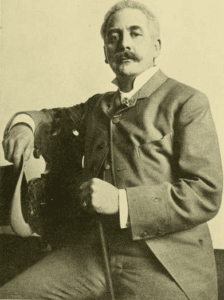
Sculptor Moses Jacob Ezekiel, photographed in 1914 in Richmond, Va. (United Daughters of the Confederacy)
The artist whose masterpiece lies at the center of the controversy, Moses Jacob Ezekiel, was born on Oct. 28, 1844, to a family with Spanish-Jewish roots. Because his father suffered financial difficulties, Moses grew up primarily with his grandparents. Attending local schools in Richmond, he worked as a clerk and bookkeeper. Despite this privation, Ezekiel showed his artistic gift early, when at the age of 13, he produced a clay bust of his father, Jacob.
With his mother’s encouragement, Moses entered the Virginia Military Institute (VMI) in 1862 and became the first Jewish cadet at that school. He was a cadet for little more than a year, when on May 10, 1864, he and his classmates were summoned to battle. “I think we all knew, when we heard those drums, what was coming,” Ezekiel later said. He and his fellow cadets were being called down the Valley of Virginia to help Gen. John C. Breckinridge “drive back the invaders. A loud hurrah showed the willingness with which those boys, between fifteen and eighteen years of age, would leave their alma mater and march toward the battlefield.”
In his memoirs, Ezekiel would recall the Battle of New Market, on May 15, 1864:
It was raining, and… we marched through fields of mud, in which I lost my shoes… Our battalion was beautifully in line when we crossed an open field. Halfway across this field, the Minié balls began to whistle around our ears, and the artillery shells came howling toward us… we advanced in as perfect order as if drawn up for dress parade.
The cadets ended up charging the enemy’s battery and fighting with handguns and bayonets before succeeding eventually in capturing a Union cannon and hoisting the VMI flag on top of it in victory.
After the War
After the war, Ezekiel began attending anatomy classes at the Virginia Military College (now the University of Virginia) but soon afterwards rejoined his father in a new business venture in Cincinnati. There Ezekiel produced, in 1868, a small clay sculpture, “Industry,” which portrayed a girl knitting socks while studying lessons from a book in her lap. This work gained its sculptor attention in the local press and paved the way for his later artistic career.
In 1869, Ezekiel moved to Berlin, where the renowned sculptor Rudolf Siemering gave him a position in his studio and where he studied life-modeling under the tutelage of Albert Wolff. It was in Germany that he developed his classical style of sculpture, and in 1873, his bas relief “Israel” would earn first place in the Prix de Rome and award him a year’s study in the Italian capital.
Later that year, Ezekiel became a member of the Jewish fraternal organization, Independent Order of B’nai B’rith, which commissioned him to sculpt “Religious Liberty.” On one side of this statue stands a woman, flanked by an enormous eagle crushing a serpent; on the other, a young boy holds the Constitution and, alongside it, brandishes an eternal flame. Ezekiel created this work in 1874, and it remains on permanent display at the Weitzman National Museum of American Jewish History; its inscription reads, “Religious Liberty, Dedicated to the People of the United States by the Order B’nai B’rith and Israelites of America.” Of this work, Ezekiel proclaimed, “I feel my inability to express myself fully on this expansive subject, and I must now beg of you to allow my work to speak for itself and for me.”
Through his art, Ezekiel would frequently celebrate his upbringing, his countrymen, and his training. In 1877, he turned his artistic energies to other themes when he accepted a commission from American financier W. W. Corcoran to create, for the Corcoran Gallery of Art, 11 marbles of history’s great artists, which included a sculpture of Michelangelo and another of Leonardo Da Vinci.
In 1879, Ezekiel established a studio in Rome at the ancient Baths of Diocletian, where, amidst his works of art, he displayed a large Confederate battle flag. Among many visitors and admirers were President Ulysses S. Grant, the U.S. Ambassador to Italy and Virginian Thomas Nelson Page, the composer Franz Liszt, and Gustav Adolf, Cardinal Prince of Hohenlohe-Schillingsfürst. Ezekiel would memorialize the last two dignitaries through his art. He would also execute a bust of Rabbi Isaac Mayer Wise, who was then America’s most famous exponent of Reform Judaism.
In 1900, Ezekiel donated “Virginia Mourning Her Dead” to his alma mater, VMI, in honor of the cadets who served with him at the Battle of New Market, in 1864. The remains of six cadets, one of whom died in Ezekiel’s arms (Thomas Garland Jefferson), are set in a copper box in the foundation of the monument. Fourteen years after the unveiling of “Virginia Mourning Her Dead,” Ezekiel would receive his last and greatest commission. This came as a result of fundraising by private groups, including the United Daughters of the Confederacy, several organizations of Union veterans, and direct contributions from a number of former Union officers. With these funds from diverse sources, the artist produced the Confederate Monument, which he had named the “New South,” at Arlington National Cemetery.
Quite understandably, Ezekiel would think of this 32-foot bronze monument as the “crowning achievement” of his career. Beneath his monument, Ezekiel placed a modest artist’s plaque, reading “Moses J. Ezekiel, Sergeant of Company C, Battalion of Cadets of the Virginia Military Institute.”
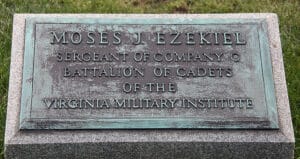
Sculptor Moses Jacob Ezekiel’s grave marker, in Arlington National Cemetery (United Daughters of the Confederacy)
Ezekiel’s funeral ceremony in 1921 was the first held in the new amphitheater at Arlington; it was presided over by U.S. Secretary of War John W. Weeks. Ezekiel had died in 1917 in Rome, but World War I had delayed the return of his body to Virginia. To honor Ezekiel’s return to his native soil, the U.S. Marine Band played “Love’s Dream,” a composition by his close friend, the composer Franz Liszt. President Warren G. Harding conveyed a message, describing Ezekiel as “a great Virginian, a great artist, a great American, and a great citizen of world fame.” Another eulogist, Sampson D. Oppenheim, would write of him, “the exigencies of his art made it necessary for Moses Ezekiel to reside far from his native land, but he never forgot that he was a Virginian, an American, a Jew.”
It is this majestic memorial to American war dead from the South that the Naming Commission now proposes to remove. To do so would not only efface a great work of art but would also obscure, if not obliterate, the memory of an internationally acclaimed artist. Encouraged by Robert E. Lee, among others, to make a name for himself and for his people, Ezekiel would write:
The race to which I belong had been oppressed and looked down upon through so many ages, I felt that I had a mission to perform. That mission was to show that, as the only Jew born in America up to that time who had dedicated himself to sculpture, I owed it to myself to succeed in doing something worthy in spite of all the difficulties and trials to which I was subjected.
Six American presidents, two of whom had been Union commanders—Ulysses S. Grant, William McKinley, Theodore Roosevelt, William Howard Taft, Woodrow Wilson, and Warren G. Harding—honored Ezekiel and the Southern war dead. They recognized Ezekiel as one of America’s greatest artists, honored his memory, and proclaimed him to be a great American. Until very recently, every president since 1914 has sent a wreath to Ezekiel’s monument in honor of the valor of Southern soldiers buried at Arlington and in honor of the man who memorialized them.
“In reality, no one in the South would have raised an arm to fight for slavery,” Ezekiel would write of the cause for which he fought. “It was an evil we had inherited and wanted to get rid of. Our struggle was simply a constitutional one, based upon state’s rights, and especially on free trade, and no tariff.” Not at all surprisingly, on the east face of his memorial showing Southerners going to war, Ezekiel depicted black soldiers in Southern uniform as well as a black woman tending to a white child. Ezekiel did view the war, after all, as a struggle for Southern independence and considered Southern blacks, including slaves, to be quintessentially Southern.
In reality, no one in the South would have raised an arm to fight for slavery. It was an evil we had inherited and wanted to get rid of. Our struggle was simply a constitutional one, based upon state’s rights, and especially on free trade, and no tariff. –Moses Ezekiel
Ignorant of Ezekiel’s words and accomplishments, Seidule and the Naming Commission have now chosen to denigrate his memory by removing the memorial that marks the zenith of his achievements. Our rulers thereby imply that Moses Ezekiel and those millions of Americans who are descendants of Confederate veterans are something less than human. Just as President Biden characterized Trump supporters as an un-American “riotous mob, insurrectionists, [and] domestic terrorists,” so too have Seidule and the Naming Commission justified the removal of Ezekiel’s monument by claiming it honors nothing more than insurrectionists, unworthy of any mention in a reconstructed “American” society.
Nearly 100 million Americans are descended from those who served the Confederacy. If not all, a vast majority of these Americans are proud of their kinfolk and the courage they exhibited during the Civil War. The monument that honors these patriots and their families—whom the woke government in D.C. seems hellbent on shoving down a memory hole—sits next to the graves of six cadets who served at the Virginia Military Institute as cadet captains. Two other VMI cadets are buried nearby, including later Marine Commandant Randolph McCall Pate, himself a descendant of a Confederate veteran. By what moral authority has the fanatical leftist elite within today’s military and Congress threatened to remove the memorial that honors these men? They have taken unto themselves the right to determine who is and who is not an American and who should be removed from historical memory.
Curiously, until just a few years ago—that is, before the Southern Poverty Law Center (SPLC) went on the warpath to remove the Confederate Memorial and before the Biden-Austin regime obligingly took up this dubious cause—Ezekiel’s work was certainly not considered a vehicle for spreading hate or bigotry. Ezekiel himself enjoyed widespread respect as a gifted sculptor, a Southern Jewish luminary, and a celebrant of religious tolerance and national reconciliation. As late as the end of 2018, mainstream historical websites provided sympathetic treatments of Ezekiel and his monument at Arlington National Cemetery.
The total reversal of this widespread acclaim and the beginning of the agitation against Ezekiel’s work has only started quite recently, which may lead us to ask what kind of historical devastation and humiliation our woke masters have planned for their hapless countrymen next. Perhaps tomorrow the cultural terrorists at the SPLC, the shapers of feminine opinion at The View, or the regime stenographers at The Atlantic will decide to dehumanize another artist for not conforming anachronistically to an even more ratcheted-up standard of political correctness. Should we then prepare for having other long-dead war heroes or artists removed from the human race or for being figuratively exhumed from their graves and publicly spat upon before being excised from the history books?
Great art is a refuge. For the South especially, but also for humanity in general, Ezekiel’s art has offered and exemplified a reprieve in the long defeat, but the high-minded “lost cause” is ever with us, and Caesar the destroyer comes calling again, disturbing the dead and rousing us to resist his iron fist.
EDITORS NOTE: You may contact your US Senator and Congressman at the following links. Simply enter your state and district at the website. Remind them that you want the Arlington Confederate Peace Memorial to stay where it is:
RELATED STORIES:
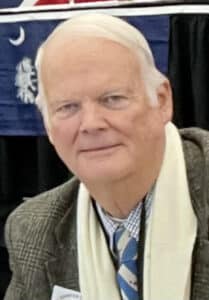
The Standard is being censored by dominant social media groups like YouTube who removed and destroyed all of our video work without permission or remuneration. That has disrupted all potential donations from our many supporters on that venue. If you want to continue to see independent thought and reports please “like”, comment, share with a friend, and donate to support The Standard on this page to assure the continued availability of news that is ignored too often by the dominant media.

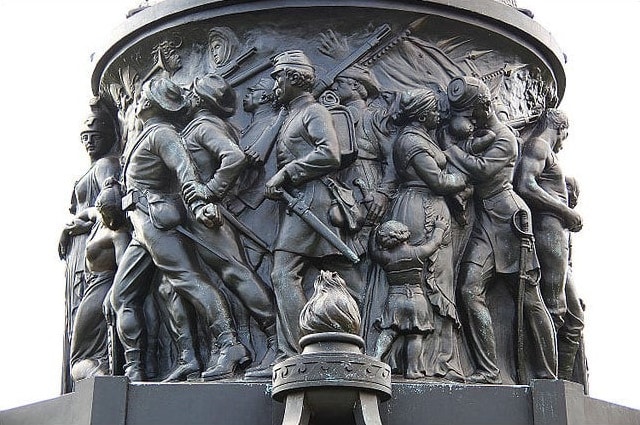
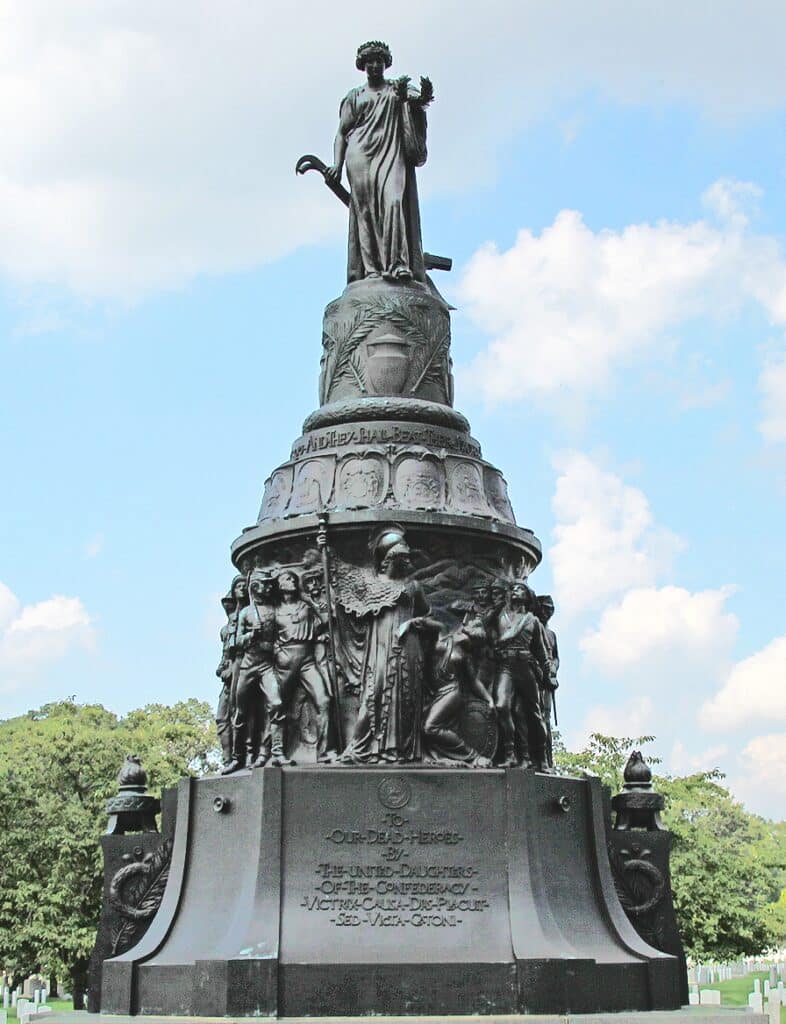
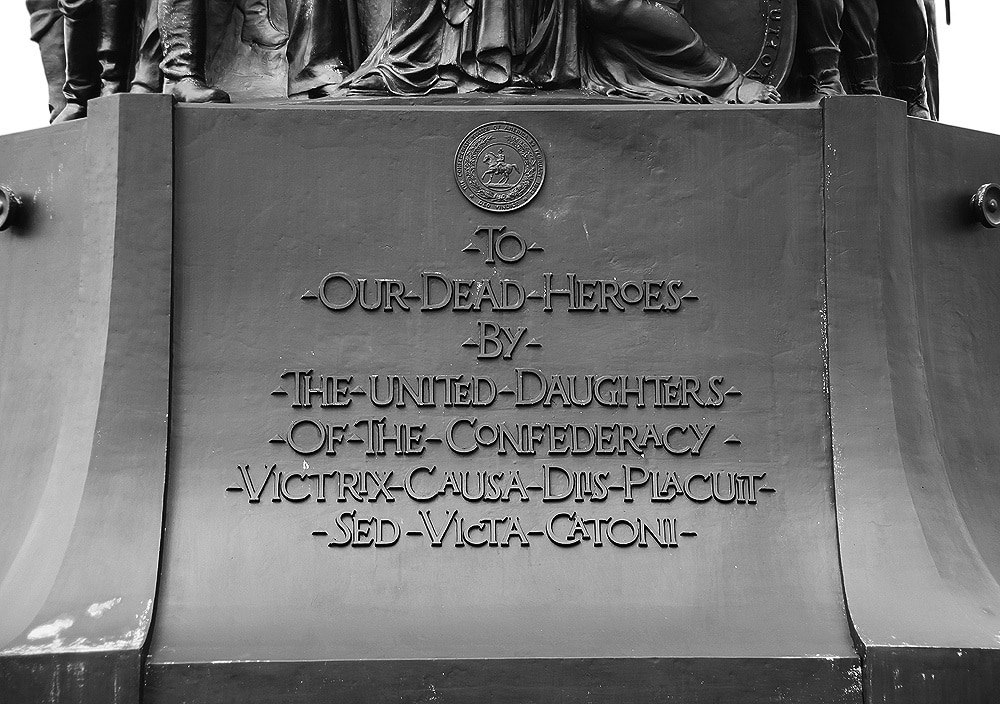


 RSS - Posts
RSS - Posts
my article on the symoblogy of this and other monuments appeared in American Thinker (can be reprinted if mentioned they had first printing. https://www.americanthinker.com/articles/2022/12/understanding_monuments_and_their_meanings.html
My work on the National Register Eligibity and the adverse effects on the Arlington National Cemetery Historic District, determination of eligiblity for the monument itself, and adverse effects to it.
https://www.academia.edu/92580753/Headstone_of_the_Confederate_States_Moses_Ezekiel_s_Arlington_Confederate_Monument_Symbolism_Meaning_National_Register_Eligibility_and_Potential_Adverse_Effects_to_Alternations_or_Removal